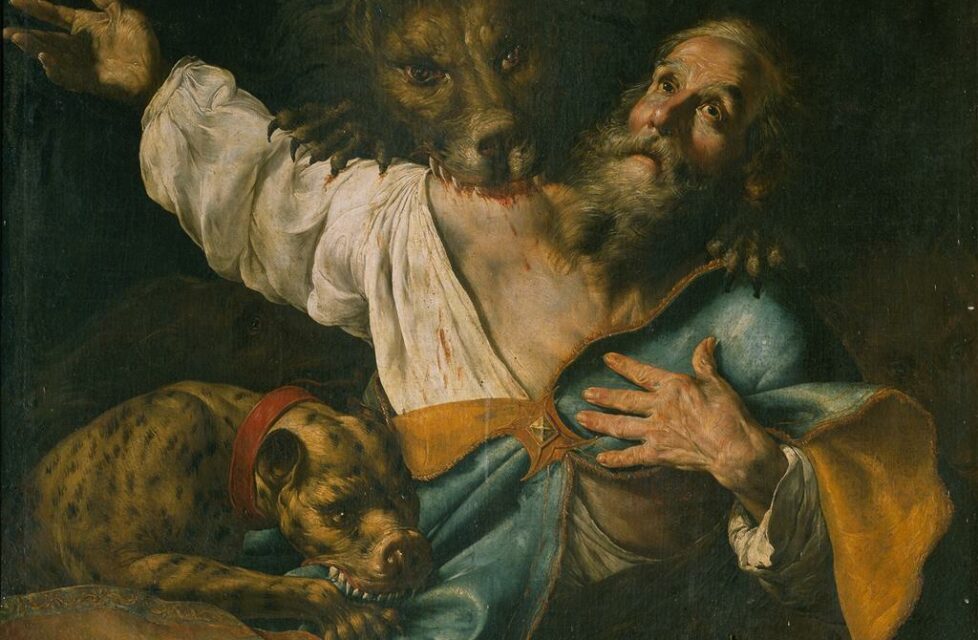Arrests, beatings, and intimidation had become common. A groupof believers were randomly rounded up and carted off to Herod’sdungeon. Among them happened to be one of the apostles—James. The event seemed little more than the usual inconvenient harassment that the Roman leaders felt obligated to perform at the insistence of certain Jewish leaders, who seemed obsessed with the followers of Jesus. But things took a sudden turn when James was hauled out without fanfare and summarily executed by the sword. The church in Jerusalem was stunned; their opponents were elated (Acts 12:1-2). James’s death turned out to be a political experiment on Herod’spart. He must have been sick and tired of the bickering in his courtover the Christ-followers who seemed to be spreading like an infection. They didn’t do anything wrong except provoke extreme hatredfrom others. But when the old politician saw the excited response toJames’s death among his political allies, Herod decided he couldafford to eliminate a few more of these Christians. His attempt to killPeter failed, and before he could devise a further plan, he was distracted by a crisis in another part of his kingdom. Herod died shortlythereafter when “an angel of the Lord struck him down,
Read MoreIf the queen and the archbishop had their way, Puritan preacher JohnPenry would simply and quietly disappear from the face of the earth.Why else would he be dragged suddenly, at about the dinner hour,from his cell near Old Kent Road and told to prepare for death? Whyelse were the gallows so quickly erected and the sheriff ordered to denythe condemned man a customary courtesy: a farewell speech affirminghis innocence and loyalty? Why else, apart from sheer hatred, would thefather of four young daughters be condemned as a traitor on the basis ofwritings never published or released to the public? Penry was born on a farm near Llangammarch, Cefn Brith, Wales,and converted early in his life to Protestant faith. In England, to be aproper Protestant was to be a member of the Church of England, whichrecognized the queen as its head. An improper Protestant was part of thedissenting or free church movement, which was tantamount to disloyaltyto her majesty, potentially an act of treason. That potential could be apowerful tool in the hands of political enemies, and Penry had one—thearchbishop of Canterbury, John Whitgrift. Penry had indirectly criticizedthe archbishop for failing to provide Wales with Christian nurture in his1587 tract entitled
Read MoreJohn Nesbit was a fighter, a soldier in the Thirty Years War on theContinent, a warrior among the Scottish Covenanters. But hesuffered scars and wounds of the heart nearly more severe thanthose of the body. By the time he was captured and tried, he wasalready taking leave of the struggles he had seen on Earth and waseager for Heaven. When Nesbit returned from war in Europe, King Charles II hadbegun to impose his will on Scotland and the Scottish church, a willopposed by the determined free-church Covenanters. They resisted anyking as church-head and the king’s priests as intermediaries. The Covenanters believed with equal ferocity in Christ alone as head of thechurch and armed resistance as the right of all who seek to worshipthat way. The Covenanters would not bow to Charles without a fight. But Nesbit had other business, too. He married Margaret Lawand they raised a family. He kept a handwritten New Testamentpassed on to him from a great-grandfather who was one of the barefoot preachers sent to England in the fourteenth century by JohnWycliffe. He studied, learned, worked, prayed, and often hid fromCharles’s dragoons. But he couldn’t hide forever. Severely injured on the field at RullianGreen, Nesbit was
Read MoreMichael Sattler was born in 1495 and became a monk. Likemany Reformation-era monks, he wrestled with his sensualpassions and his love for God. Sattler broke his oath of celibacy for an equally unavailable woman named Margarita, a nun whoalso broke her oath for marital love. Later, the Sattlers would die for afar greater love: their bond with God. By 1526, the Sattlers had returned to the Anabaptist movement,which Michael had been forced to renounce years earlier to avoid imprisonment. Now, with his Anabaptist convictions strengthened, Michael dedicated his life to preaching at a church in Horb, a strongly Catholic region of Austria. On February 4, 1527, in the small German town of Schleitheim, the Anabaptists met and introduced to the world a new way of understanding church and Gospel. The Sattlers traveled to Germanyfrom Horb for the deliberations that produced the “Seven Articles of theFaith,” also known as the “Brotherly Union.” Michael Sattler helpedwrite this founding document of the Anabaptist movement. But traveling home from that meeting, Michael and Margarita Sattler were captured and their articles confiscated. They were transformedfrom Anabaptist advocates to Anabaptist martyrs—a twist of events thatpropelled the church further than Sattler could ever have imagined.Tried before a
Read MoreTwo men named Philip occupied the stage in the early church. Onewas Philip the apostle, the first person called by Jesus to followHim. The other was Philip the evangelist, one of the seven chosenby the church to help with the special needs of the growing band ofbelievers in Jerusalem. Both men had similar evangelistic hearts, and theaccounts of their lives have often been intertwined in subsequent history.Their stories are further complicated because they each appear to havefathered several daughters. Philip the apostle is mentioned several timesin the Gospel of John but only once in the book of Acts (1:13). Philip thedeacon appears in Acts and is instrumental in the conversion of theEthiopian eunuch as well as in the spiritual outbreak among the Samaritans, recorded by Luke in Acts 8. Philip the deacon later hosted theapostle Paul on his last journey to Jerusalem (Acts 21:8). They may havehad further contact during the two years that Paul was imprisoned inCaesarea before his journey under guard to Rome. Philip the apostle came from Bethsaida, a town in northern Israelclose to Capernaum and the Sea of Galilee. His non-Jewish name mayindicate the degree to which Bethsaida was influenced by the Greekculture and government language
Read MoreConvinced that the intolerant law of Massachusetts Colonybanishing Quakers violated God’s law, Mary Dyer would notstay quiet or stay away. Dyer was a Quaker, and Quakersbelieved that God could communicate directly to us and that salvationcould be assured. This was considered heresy by the Puritans in Massachusetts, so they banished her from the colony. Dyer challenged that law with a persistence that finally led authorities to a critical decision: Agree with Dyer and change the social structureof the colony, or silence her. Mary Dyer died on the gallows on June 1,1660, affirming her stand against the government that persecuted herQuaker faith. “Nay, man,” she said at the last, “I am not now to repent.”Dyer had other alternatives. For one, she was married to a respectedcolonial official, William Dyer, who more than once had rescued herfrom a Massachusetts jail through his political connections. He too wasa Quaker but less militant than she, who never dodged a fight over religious freedom, especially when her “inner light”—God’s voice to thesoul—bade her confront the secular powers. For another, Dyer had the testy patience of Massachusetts GovernorJohn Endicott on her side. When her fellow Quaker “lawbreakers,” William Robinson and Marmaduke Stephenson, were hanged in 1658,
Read MorePerhaps Christendom’s greatest historical embarrassment, the Crusades, at the time were a brilliant strategic move by papal leaders to unite a warring Europe against heathen enemies threatening the Byzantine church. Not that Pope Urban II in Rome cared much about Constantinople or vice versa. Each part of the church had excommunicated the other in the Great Schism of 1054. But internal feuding needed alternative war games, and the call to defend the Holy Land and the Eastern Church against invading Turks presented a quite legitimate target for knights and lords otherwise bent on battling each other. The First Crusade, led by Peter the Hermit in 1095, was a militarydisaster. The same could be said for one of the last crusades—the Children’s Crusade of 1212—when hundreds of youngsters sailed fromMarseilles toward Palestine and fell into the hands of slave traders.Between these, however, many great medieval reputations were made.Richard the Lion-Hearted of England was one of many who led armiesto victory, his soldiers bearing the famous sign of the Red Cross. In 1099,Jerusalem was taken. When Godfrey of Bouillon was offered the throneof Jerusalem, he refused to wear a crown of gold in the city where hisSavior had once worn a crown
Read MoreLiao Qiang and his family, members of the Early Rain Covenant Church, fled to Taiwan in July 2019 after repeated interrogation and harassment by the police. On June 29, the family of six arrived safely in the United States, where they will apply for asylum. Following the government raid of Early Rain Covenant Church on Dec. 9, 2018, Liao and his family were repeatedly interrogated, constantly surveilled, and harassed by police.
Read MoreAlimayu grew up in in a Christian home in the northern part of Ethiopia. As a young man, he placed his faith in Christ and became an active member of a local church. He is married with two children, and he runs a small café in Shashemane. In July, youth mobs destroyed Alimayu’s business in riots that targeted the homes and businesses of non-indigenous people and Christians.
Read MoreFariba is married to a drug addict, and they have a teenage son. They live in a small room in a machine shop, and Fariba works long hours as a housecleaner to try to make ends meet. Desperate and hopeless, Fariba decided to commit suicide because she felt her life was worthless.
Read More

